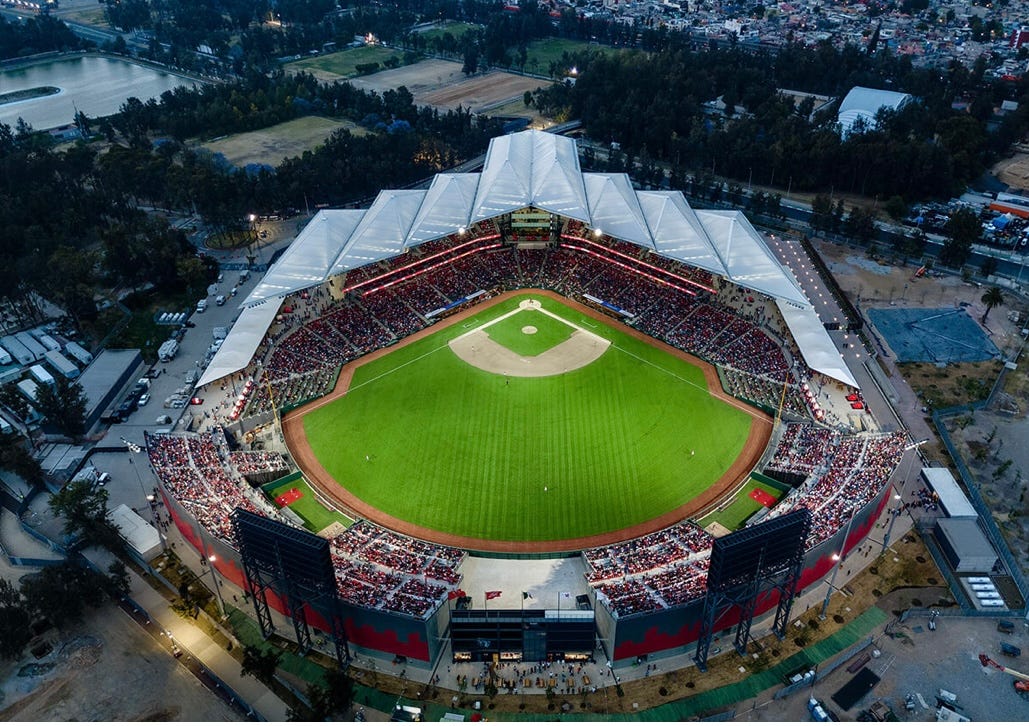Going global
With the Padres and Giants playing in Mexico City this weekend, a suggestion as to how Major League Baseball can continue to expand its international reach

Last month’s World Baseball Classic was a reminder of the sport’s extraordinary popularity in some parts of the world and its potential for continued growth elsewhere.
Baseball is already ingrained in the cultural fabric across Latin America and in several Asian countries, and events like the WBC show reasons for optimism that the game’s profile can be grown in Europe, opening important new revenue streams—and potentially even new talent streams—to MLB and its 30 clubs.
The internationalization of Baseball was an important priority of former Commissioner Bud Selig’s and remains a point of emphasis for Rob Manfred. According to MLB.com, MLB has played more than 200 international exhibition or regular season games in 11 countries or territories over the last 30 years, with teams traveling as far as Japan, China and Australia.
The Padres and Giants will play at Estadio Alfredo Harp Helú in Mexico City tonight and tomorrow, the first MLB regular season series to be played in the Mexican capital city.
And the Cubs and Cardinals will take their rivalry to London Stadium June 24-25.
While these trips do much to promote the Game globally, one of the drawbacks is you sometimes hear teams that have made them talk about being put at a competitive disadvantage by the excessive travel during the spring, at the start of their season or even mid-season, their routines and the rhythm of the season disrupted.
So how can Baseball reap the rewards of these important trips but also make the challenges more of a shared sacrifice?
Here’s a proposal:
Once every 3 years (maybe the year before each WBC to help build excitement), all 30 major league teams would open their seasons with 2 international games. While there may not currently be 15 international markets that already have a stadium whose facilities and, most importantly field dimensions, could accommodate a regulation MLB field, you can basically cut the number of facilities you need in half by sending groups of 4 teams to each of 7 different cities and 2 teams to an 8th city.
In the 4-team cities, you could play 2 days of day-night doubleheaders, with each team playing one game a day and each team giving up only one home opening, so they’d still play 80 games in their home ballpark.
For example, the Marlins, Dodgers, Mariners and White Sox could open the season in London. On the first day, the Marlins could play as the home team in a day game against the Dodgers, and the Mariners could play as the home team at night against the White Sox. On day 2, your doubleheader could match the Marlins as the visitor against the White Sox at night after the Dodgers play as the home team against the Mariners.
While those 4 teams are playing in London, you could have 4 teams in Tokyo, 4 in Rome, 4 in Sydney, 4 in Santo Domingo, 4 in Mexico City, 4 in San Juan and 2 in Madrid. You could play games in Venezuela, in South Korea, in Taiwan.
MLB has already announced its intention to play regular season games at the Stade de France, just outside of Paris, in 2025. We’ve seen previous exhibition games in Panama and China. There are large national stadiums in Nicaragua and Colombia that could host games. Maybe one day regular season games could be played in Cuba, where MLB has previously staged exhibitions.
While virtually all of the cities and countries mentioned already have facilities capable of hosting regular season major league games, with pop-up ballparks having been built in the middle of a cornfield at the Field of Dreams in Dyersville, Iowa and at Fort Bragg, NC—where the Marlins and Braves honored the troops in 2016—MLB has shown it can host games anywhere.
Some of these markets could host games in every international year, while others can be inserted into a rotation to include new and emerging Baseball markets with facilities that meet the major league standard.
These Baseball-wide international openers could be a huge boost to the sport around the world while exposing all 30 clubs to the benefits—and the challenges—of helping broaden Major League Baseball’s world-wide appeal.
DID YOU KNOW?: According to MLB research, there were 269 internationally born players, hailing from 19 countries or territories, on Opening Day rosters or the IL in 2023, an average of 9 per club. That total represents 28.5 percent of the players who opened the year on big league rosters.
As has been the case every year since 1995, when this data was first tracked, the Dominican Republic led the way with 104 players on Opening Day rosters.
Venezuela ranked 2nd with 62. Cuba had 21, Puerto Rico 19 and Mexico rounded out the top 5 with 15, its most since 2005.
Canada had 10 native-born players on Opening Day rosters, Japan 8 and Colombia 7. Curacao, Panama and South Korea all had 4. The Bahamas and Nicaragua had 2, while Aruba, Australia, Brazil, Germany, Honduras and Taiwan had one apiece.
The Astros had a ML-leading 16 international players on their Opening Day roster, most in baseball for the 3rd straight year. The Twins and Padres both had 15. The Marlins and Yankees tied for 4th with 13.


